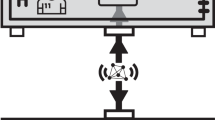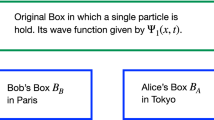Abstract
Correlations are generally described by one of two mechanisms: either a first event influences a second one by sending information encoded in bosons or other physical carriers, or the correlated events have some common causes in their shared history. Quantum physics predicts an entirely different kind of cause for some correlations, named entanglement. This reveals itself in correlations that violate Bell inequalities (implying that they cannot be described by common causes) between space-like separated events (implying that they cannot be described by classical communication). Many Bell tests have been performed1, and loopholes related to locality2,3,4 and detection5,6 have been closed in several independent experiments. It is still possible that a first event could influence a second, but the speed of this hypothetical influence (Einstein’s ‘spooky action at a distance’) would need to be defined in some universal privileged reference frame and be greater than the speed of light. Here we put stringent experimental bounds on the speed of all such hypothetical influences. We performed a Bell test over more than 24 hours between two villages separated by 18 km and approximately east–west oriented, with the source located precisely in the middle. We continuously observed two-photon interferences well above the Bell inequality threshold. Taking advantage of the Earth’s rotation, the configuration of our experiment allowed us to determine, for any hypothetically privileged frame, a lower bound for the speed of the influence. For example, if such a privileged reference frame exists and is such that the Earth’s speed in this frame is less than 10-3 times that of the speed of light, then the speed of the influence would have to exceed that of light by at least four orders of magnitude.
This is a preview of subscription content, access via your institution
Access options
Subscribe to this journal
Receive 51 print issues and online access
$199.00 per year
only $3.90 per issue
Buy this article
- Purchase on Springer Link
- Instant access to full article PDF
Prices may be subject to local taxes which are calculated during checkout





Similar content being viewed by others
References
Aspect, A. Bell’s inequality test: more ideal than ever. Nature 398, 189–190 (1999)
Aspect, A. et al. Experimental realization of Einstein-Podolsky-Rosen-Bohm Gedankenexperiment: A new violation of Bell’s inequalities. Phys. Rev. Lett. 49, 91–94 (1982)
Tittel, W., Brendel, J., Zbinden, H. & Gisin, N. Violation of Bell inequalities by photons more than 10 km apart. Phys. Rev. Lett. 81, 3563–3566 (1998)
Weihs, G., Jennewein, T., Simon, C., Weinfurter, H. & Zeilinger, A. Violation of Bell’s inequality under strict Einstein locality conditions. Phys. Rev. Lett. 81, 5039–5043 (1998)
Rowe, M. A. et al. Experimental violation of a Bell’s inequality with efficient detection. Nature 409, 791–794 (2001)
Matsukevich, D. N. et al. Bell inequality violation with two remote atomic qubits. Phys. Rev. Lett. 100, 150404 (2008)
Eberhard Quantum Theory and Pictures of Reality (ed. Schommers, W.) 169–216 (Springer, Berlin, 1989)
Scarani, V. et al. The speed of quantum information and the preferred frame: analysis of experimental data. Phys. Lett. A 276, 1–7 (2000)
Feinberg, G. Possibility of faster-than-light particles. Phys. Rev. 159, 1089–1105 (1967)
Bohm, D. A suggested interpretation of the quantum theory in terms of “hidden” variables I. Phys. Rev. 85, 166–179 (1952)
Bohm, D. A suggested interpretation of the quantum theory in terms of “hidden” variables II. Phys. Rev. 85, 180–193 (1952)
Bohm, D. & Hiley, B. J. The Undivided Universe 293 (Routledge, London, 1993)
Gisin, N., Scarini, V., Tittel, W. & Zbinden, H. Optical tests of quantum nonlocality: from EPR-Bell tests towards experiments with moving observers. Annal. Phys. 9, 831–841 (2000)
Zbinden, H. et al. Experimental test of nonlocal quantum correlation in relativistic configurations. Phys. Rev. A 63, 022111 (2001)
Garisto, R. What is the speed of quantum information? Preprint at 〈http://arxiv.org/abs/quant-ph/0212078〉 (2002)
Franson, J. D. Bell inequality for position and time. Phys. Rev. Lett. 62, 2205–2208 (1989)
Tanzilli, S. et al. PPLN waveguide for quantum communication. Eur. Phys. J. D 18, 155–160 (2002)
Thew, R. et al. Experimental investigation of the robustness of partially entangled qubits over 11 km. Phys. Rev. A 66, 062304 (2002)
Clauser, J. F., Horne, M. A., Shimony, A. & Holt, R. A. Proposed experiment to test local hidden-variable theories. Phys. Rev. Lett. 23, 880–884 (1969)
Scholder, F., Gautier, J.-D., Wegmüller, M. & Gisin, N. Long-distance OTDR using photon counting and large detection gates at telecom wavelength. Opt. Commun. 213, 57–61 (2002)
Passy, R. et al. Experimental and theoretical investigations of coherent OFDR with semiconductor laser sources. J. Lightwave Technol. 12, 1622–1630 (1994)
Brendel, J., Gisin, N. & Zbinden, H. in Proc. 5th Opt. Fiber Measurement Conf. (eds Boisrobert, Ch. & Tanguy, E.) 12–17 (Université de Nantes, Nantes, 1999)
Acknowledgements
We acknowledge technical support by J.-D. Gautier and C. Barreiro. The access to the telecommunications network was provided by Swisscom. This work was supported by the Swiss NCCR Quantum Photonics and the European Union project QAP. The image of the Earth in Fig. 1 is a NASA Goddard Space Flight Center Image by R. Stöckli.
Author information
Authors and Affiliations
Corresponding author
Supplementary information
Supplementary information
The file contains Supplementary Figures 1-3 with Legends and Supplementary Discussion on the details of the experimental setup, the phase scan, the visibility fitting method and the process followed to find an expression for |β||(t)|. and upper bounds for |β||(t)|. (PDF 374 kb)
Rights and permissions
About this article
Cite this article
Salart, D., Baas, A., Branciard, C. et al. Testing the speed of ‘spooky action at a distance’. Nature 454, 861–864 (2008). https://doi.org/10.1038/nature07121
Received:
Accepted:
Issue Date:
DOI: https://doi.org/10.1038/nature07121
This article is cited by
-
Schrödinger Cats and Quantum Complementarity
Foundations of Physics (2024)
-
Applications of single photons to quantum communication and computing
Nature Reviews Physics (2023)
-
Resolution of 100 photons and quantum generation of unbiased random numbers
Nature Photonics (2023)
-
Testing the speed of “spooky action at a distance” in a tabletop experiment
Scientific Reports (2023)
-
Social science goes quantum: explaining human decision-making, cognitive biases and Darwinian selection from a quantum perspective
Journal of Bioeconomics (2023)
Comments
By submitting a comment you agree to abide by our Terms and Community Guidelines. If you find something abusive or that does not comply with our terms or guidelines please flag it as inappropriate.



